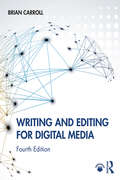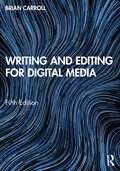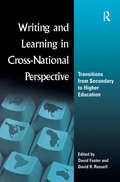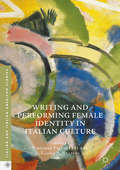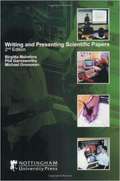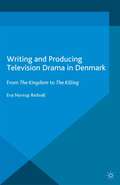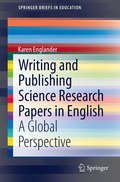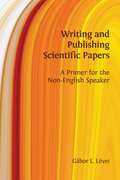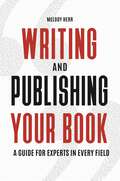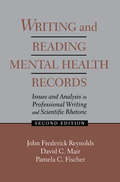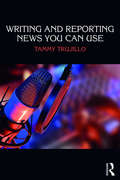- Table View
- List View
Writing and Editing for Digital Media
by Brian CarrollIn this new edition, Brian Carroll explores writing and editing for digital media with information about voice, style, media formats, and content development, combining hands-on exercises with new sections on idea generation, multi-modal storytelling, podcasting, and information credibility. Carroll explains and demonstrates how to effectively write for digital spaces – whether crafting a story for a website, writing for an app, blogging, or using social media to expand the conversation. Each chapter features lessons and exercises through which students can build a solid understanding of the ways that digital communication provides opportunities for dynamic storytelling and multi-directional communication. Updated with contemporary examples and new pedagogy, the fourth edition broadens its scope, helping digital writers and editors in all fields, including public relations, marketing, and social media management. Writing and Editing for Digital Media is an ideal handbook for students from all backgrounds who are looking to develop their writing and editing skills for this ever-evolving industry.
Writing and Editing for Digital Media
by Brian CarrollIn this new edition, Brian Carroll explores writing and editing for digital media with information about voice, style, media formats, and content development, combining hands-on exercises with new sections on idea generation, multi-modal storytelling, podcasting, and information credibility. Carroll explains and demonstrates how to effectively write for digital spaces – whether crafting a story for a website, writing for an app, blogging, or using social media to expand the conversation. Each chapter features lessons and exercises through which students can build a solid understanding of the ways that digital communication provides opportunities for dynamic storytelling and multi-directional communication. Updated with contemporary examples and new pedagogy, the fourth edition broadens its scope, helping digital writers and editors in all fields, including public relations, marketing, and social media management. Writing and Editing for Digital Media is an ideal handbook for students from all backgrounds who are looking to develop their writing and editing skills for this ever-evolving industry.
Writing and Editing for Digital Media
by Brian CarrollIn this fifth edition, Brian Carroll explores writing and editing for digital media with essential information about voice, style, media formats, ideation, story planning, and storytelling. Carroll explains and demonstrates how to effectively write for digital spaces and combines hands-on, practical exercises with new material on podcasting, multi-modal storytelling, misinformation and disinformation, and writing specifically for social media. Each chapter features lessons and exercises through which students can build a solid understanding of the ways that digital communication provides opportunities for dynamic storytelling and multi-directional communication. Broadened in scope, this new edition also speaks to writers, editors, public relations practitioners, social media managers, marketers, as well as to students aspiring to these roles. Updated with contemporary examples and new pedagogy throughout, this is the ideal handbook for students seeking careers in digital media, particularly in content development and digital storytelling. It is an essential text for students of media, communication, public relations, marketing, and journalism who are looking to develop their writing and editing skills for these ever-evolving fields and professions. This book also has an accompanying eResource that provides additional weekly activities, exercises, and assignments that give students more opportunity to put theory into practice.
Writing and Editing for Digital Media
by Brian CarrollIn this fifth edition, Brian Carroll explores writing and editing for digital media with essential information about voice, style, media formats, ideation, story planning, and storytelling. Carroll explains and demonstrates how to effectively write for digital spaces and combines hands-on, practical exercises with new material on podcasting, multi-modal storytelling, misinformation and disinformation, and writing specifically for social media. Each chapter features lessons and exercises through which students can build a solid understanding of the ways that digital communication provides opportunities for dynamic storytelling and multi-directional communication. Broadened in scope, this new edition also speaks to writers, editors, public relations practitioners, social media managers, marketers, as well as to students aspiring to these roles. Updated with contemporary examples and new pedagogy throughout, this is the ideal handbook for students seeking careers in digital media, particularly in content development and digital storytelling. It is an essential text for students of media, communication, public relations, marketing, and journalism who are looking to develop their writing and editing skills for these ever-evolving fields and professions. This book also has an accompanying eResource that provides additional weekly activities, exercises, and assignments that give students more opportunity to put theory into practice.
Writing and Fantasy (Crosscurrents)
by Ceri Sullivan Barbara WhiteWriting and Fantasy brings together essays which restore a sense of the fantastic as a political response to cultural opportunities and pressures. It moves on from two conventional fields of discussion: the psychoanalytic, where phantasies are produced by the emergence of the consciousness, and the social, where fantasies are the production of nineteenth-century individualism. Chapters run from the classical period to the twentieth century, each focusing on a local reading of how fantasy acts as a strategy to contain or exploit specific historical and cultural moments. A wide variety of sites are investigated including the feminization of the wild west, originary and maternal spaces, highwaywomen, financial credit, and the ideal home. Multiple genres containing fantasy are explored, ranging from ghost stories to feminist utopias.Aids to the reader include an introduction summarising recent discussions of fantasy, illustrations dealing with visual fantasies, and an annotated bibliography. The new research presented here will be of great interest to academics and students in literature, history and cultural studies departments who are working in the field of the historical development of concepts of fantasy, cultural opposition, and the imbrication of politics and modes of representation.
Writing and Fantasy (Crosscurrents)
by Ceri Sullivan Barbara WhiteWriting and Fantasy brings together essays which restore a sense of the fantastic as a political response to cultural opportunities and pressures. It moves on from two conventional fields of discussion: the psychoanalytic, where phantasies are produced by the emergence of the consciousness, and the social, where fantasies are the production of nineteenth-century individualism. Chapters run from the classical period to the twentieth century, each focusing on a local reading of how fantasy acts as a strategy to contain or exploit specific historical and cultural moments. A wide variety of sites are investigated including the feminization of the wild west, originary and maternal spaces, highwaywomen, financial credit, and the ideal home. Multiple genres containing fantasy are explored, ranging from ghost stories to feminist utopias.Aids to the reader include an introduction summarising recent discussions of fantasy, illustrations dealing with visual fantasies, and an annotated bibliography. The new research presented here will be of great interest to academics and students in literature, history and cultural studies departments who are working in the field of the historical development of concepts of fantasy, cultural opposition, and the imbrication of politics and modes of representation.
Writing and Learning in Cross-national Perspective: Transitions From Secondary To Higher Education
by David FosterDespite the increasingly global implications of conversations about writing and learning, U.S. composition studies has devoted little attention to cross-national perspectives on student writing and its roles in wider cultural contexts. Caught up in our own concerns about how U.S. students make the transition as writers from secondary school to postsecondary education, we often overlook the fact that students around the world are undergoing the same evolution. How do the students in China, England, France, Germany, Kenya, or South Africa--the educational systems represented in this collection--write their way into the communities of their chosen disciplines? How, for instance, do students whose mother tongue is not the language of instruction cope with the demands of academic and discipline-specific writing? And in what ways is U.S. students' development as academic writers similar to or different from that of students in other countries? With this collection, editors David Foster and David R. Russell broaden the discussion about the role of writing in various educational systems and cultures. Students' development as academic writers raises issues of student authorship and agency, as well as larger issues of educational access, institutional power relations, system goals, and students' roles in society. The contributors to this collection discuss selected writing purposes and forms characteristic of a specific national education system, describe students' agency as writers, and identify contextual factors--social, economic, linguistic, cultural--that shape institutional responses to writing development. In discussions that bookend these studies of different educational structures, the editors compare U.S. postsecondary writing practices and pedagogies with those in other national systems, and suggest new perspectives for cross-national study of learning/writing issues important to all educational systems. Given the worldwide increase in students entering higher education and the endless need for effective writing across disciplines and nations, the insights offered here and the call for further studies are especially welcome and timely.
Writing and Learning in Cross-national Perspective: Transitions From Secondary To Higher Education
by David Foster David R. RussellDespite the increasingly global implications of conversations about writing and learning, U.S. composition studies has devoted little attention to cross-national perspectives on student writing and its roles in wider cultural contexts. Caught up in our own concerns about how U.S. students make the transition as writers from secondary school to postsecondary education, we often overlook the fact that students around the world are undergoing the same evolution. How do the students in China, England, France, Germany, Kenya, or South Africa--the educational systems represented in this collection--write their way into the communities of their chosen disciplines? How, for instance, do students whose mother tongue is not the language of instruction cope with the demands of academic and discipline-specific writing? And in what ways is U.S. students' development as academic writers similar to or different from that of students in other countries? With this collection, editors David Foster and David R. Russell broaden the discussion about the role of writing in various educational systems and cultures. Students' development as academic writers raises issues of student authorship and agency, as well as larger issues of educational access, institutional power relations, system goals, and students' roles in society. The contributors to this collection discuss selected writing purposes and forms characteristic of a specific national education system, describe students' agency as writers, and identify contextual factors--social, economic, linguistic, cultural--that shape institutional responses to writing development. In discussions that bookend these studies of different educational structures, the editors compare U.S. postsecondary writing practices and pedagogies with those in other national systems, and suggest new perspectives for cross-national study of learning/writing issues important to all educational systems. Given the worldwide increase in students entering higher education and the endless need for effective writing across disciplines and nations, the insights offered here and the call for further studies are especially welcome and timely.
Writing and Performing Female Identity in Italian Culture
by Virginia Picchietti Laura A. SalsiniThis volume investigates the ways in which Italian women writers, filmmakers, and performers have represented female identity across genres from the immediate post-World War II period to the turn of the twenty-first century. Considering genres such as prose, poetry, drama, and film, these essays examine the vision of female agency and self-actualization arising from women artists’ critique of female identity. This dual approach reveals unique interpretations of womanhood in Italy spanning more than fifty years, while also providing a deep investigation of the manipulation of canvases historically centered on the male subject. With its unique coupling of generic and thematic concerns, the volume contributes to the ever expanding female artistic legacy, and to our understanding of postwar Italian women’s evolving relationship to the narration of history, gender roles, and these artists’ use and revision of generic convention to communicate their vision.
Writing and Performing Female Identity in Italian Culture
by Virginia Picchietti Laura A. SalsiniThis volume investigates the ways in which Italian women writers, filmmakers, and performers have represented female identity across genres from the immediate post-World War II period to the turn of the twenty-first century. Considering genres such as prose, poetry, drama, and film, these essays examine the vision of female agency and self-actualization arising from women artists’ critique of female identity. This dual approach reveals unique interpretations of womanhood in Italy spanning more than fifty years, while also providing a deep investigation of the manipulation of canvases historically centered on the male subject. With its unique coupling of generic and thematic concerns, the volume contributes to the ever expanding female artistic legacy, and to our understanding of postwar Italian women’s evolving relationship to the narration of history, gender roles, and these artists’ use and revision of generic convention to communicate their vision.
Writing and Presenting Scientific Papers: 2nd edition
by B MalmforsThe aim of this book is to provide guidelines for preparing papers and presentations so that your message can be transmitted clearly and concisely to the reader or listener. Techniques for improving your writing, literature searching and training students in communication are also discussed.
Writing and Producing Television Drama in Denmark: From The Kingdom to The Killing (Palgrave Studies in Screenwriting)
by Eva Novrup RedvallOffering unique insights into the writing and production of television drama series such as The Killing and Borgen, produced by DR, the Danish Broadcasting Corporation, Novrup Redvall explores the creative collaborations in writers' rooms and 'production hotels' through detailed case studies of Denmark's public service production culture.
Writing and Publishing in Architecture and Design
by Anne MasseyThis book outlines the process of writing and publishing research in the field of architecture and design. The book sets out to help researchers find a voice and find the best fit for their work. Information about the different types of publication on offer is set out, as well as how to make that important initial approach. From pitching an idea for a review in a magazine, to producing a journal article right through to the monograph, Writing and Publishing in Architecture and Design maps out the different steps for the novice author. Your first steps in publishing can be daunting, and the book offers material which will inspire confidence, by demystifying the publication process. It also includes valuable nuts and bolts material such as planning and structure, time management, writing styles, editing, production of the final manuscript and picture research. How do you turn your PhD into a book? How do you turn conference proceedings into a publication? Commissioning editors and authors share their experiences through interview and offer recipes for success as well as what to avoid. Key titles from the past are included as case studies, and their pathway to publication explored. This is an invaluable book for anyone working in the fields of architecture and design, with an ambition to publish.
Writing and Publishing in Architecture and Design
by Anne MasseyThis book outlines the process of writing and publishing research in the field of architecture and design. The book sets out to help researchers find a voice and find the best fit for their work. Information about the different types of publication on offer is set out, as well as how to make that important initial approach. From pitching an idea for a review in a magazine, to producing a journal article right through to the monograph, Writing and Publishing in Architecture and Design maps out the different steps for the novice author. Your first steps in publishing can be daunting, and the book offers material which will inspire confidence, by demystifying the publication process. It also includes valuable nuts and bolts material such as planning and structure, time management, writing styles, editing, production of the final manuscript and picture research. How do you turn your PhD into a book? How do you turn conference proceedings into a publication? Commissioning editors and authors share their experiences through interview and offer recipes for success as well as what to avoid. Key titles from the past are included as case studies, and their pathway to publication explored. This is an invaluable book for anyone working in the fields of architecture and design, with an ambition to publish.
Writing and Publishing Science Research Papers in English: A Global Perspective (SpringerBriefs in Education)
by Karen EnglanderThis book provides a comprehensive review of the current knowledge on writing and publishing scientific research papers and the social contexts. It deals with both English and non-Anglophone science writers, and presents a global perspective and an international focus. The book collects and synthesizes research from a range of disciplines, including applied linguistics, the sociology of science, sociolinguistics, bibliometrics, composition studies, and science education. This multidisciplinary approach helps the reader gain a solid understanding of the subject. Divided into three parts, the book considers the context of scientific papers, the text itself, and the people involved. It explains how the typical sections of scientific papers are structured. Standard English scientific writing style is also compared with science papers written in other languages. The book discusses the strengths and challenges faced by people with different degrees of science writing expertise and the role of journal editors and reviewers.
Writing and Publishing Scientific Papers: A Primer for the Non-English Speaker
by Gábor L. LöveiGábor Lövei’s scientific communication course for students and scientists explores the intricacies involved in publishing primary scientific papers, and has been taught in more than twenty countries. Writing and Publishing Scientific Papers is the distillation of Lövei’s lecture notes and experience gathered over two decades; it is the coursebook many have been waiting for. The book’s three main sections correspond with the three main stages of a paper’s journey from idea to print: planning, writing, and publishing. Within the book’s chapters, complex questions such as ‘How to write the introduction?’ or ‘How to submit a manuscript?’ are broken down into smaller, more manageable problems that are then discussed in a straightforward, conversational manner, providing an easy and enjoyable reading experience. Writing and Publishing Scientific Papers stands out from its field by targeting scientists whose first language is not English. While also touching on matters of style and grammar, the book’s main goal is to advise on first principles of communication. This book is an excellent resource for any student or scientist wishing to learn more about the scientific publishing process and scientific communication. It will be especially useful to those coming from outside the English-speaking world and looking for a comprehensive guide for publishing their work in English.
Writing and Publishing Your Book: A Guide for Experts in Every Field
by Melody Herr Ph.D.Are you ready to write your book? Partner with an experienced publisher, writing coach, and author and find out how to turn your research and scholarship into a book.This book is the next-best-thing to a personal writing coach. Drawing upon her own extensive experience as an author and publisher, Melody Herr guides the reader through every step of the writing and publishing process: constructing a table of contents, preparing a proposal, finding a publisher, negotiating a contract, drafting the manuscript, and marketing the finished product. Throughout, she offers proven strategies for producing a book that highlights its author's authoritative knowledge and writing skills. Unique among writing guides, Writing and Publishing Your Book: A Guide for Experts in Every Field acknowledges the reader's own expertise; speaks to researchers and scholars across the sciences, social sciences, and humanities; and provides information and guidance that will benefit junior authors as well as their more senior colleagues. By following these practical, step-by-step instructions, new authors will more easily liberate their own creativity while avoiding the many pitfalls that mire new writers, thereby maintaining momentum for a successful publication.
Writing and Publishing Your Book: A Guide for Experts in Every Field
by Melody Herr Ph.D.Are you ready to write your book? Partner with an experienced publisher, writing coach, and author and find out how to turn your research and scholarship into a book.This book is the next-best-thing to a personal writing coach. Drawing upon her own extensive experience as an author and publisher, Melody Herr guides the reader through every step of the writing and publishing process: constructing a table of contents, preparing a proposal, finding a publisher, negotiating a contract, drafting the manuscript, and marketing the finished product. Throughout, she offers proven strategies for producing a book that highlights its author's authoritative knowledge and writing skills. Unique among writing guides, Writing and Publishing Your Book: A Guide for Experts in Every Field acknowledges the reader's own expertise; speaks to researchers and scholars across the sciences, social sciences, and humanities; and provides information and guidance that will benefit junior authors as well as their more senior colleagues. By following these practical, step-by-step instructions, new authors will more easily liberate their own creativity while avoiding the many pitfalls that mire new writers, thereby maintaining momentum for a successful publication.
Writing and Race (Crosscurrents)
by Tim YoungsWriting and Race brings together specially commissioned essays by new and established authors from a range of disciplines. Texts are drawn from subjects and genres that include philosophy, politics, anthropology, sexuality, travel, fiction and autobiography. Through a time-span from Ancient Greece to the present day, and a geographical coverage from Australia and Europe to the Caribbean and the United States, the collection investigates the importance of place, moment, cultural formation and subject identity in racial representation. A substantial introduction establishes the connections between the essays and lucidly summarizes recent thinking on race, explaining in particular the relevance of debates about ethnography.Accessible and stimulating, Writing and Race is a multidisciplinary collection that will be of interest to students, researchers, and lecturers who study or are interested in race. The essays represent a variety of critical approaches, thus allowing the reader to compare and contrast the benefits of each approach. Extracts of some of the texts that are discussed are included along with an extensive bibliography to encourage further study.
Writing and Race (Crosscurrents)
by Tim YoungsWriting and Race brings together specially commissioned essays by new and established authors from a range of disciplines. Texts are drawn from subjects and genres that include philosophy, politics, anthropology, sexuality, travel, fiction and autobiography. Through a time-span from Ancient Greece to the present day, and a geographical coverage from Australia and Europe to the Caribbean and the United States, the collection investigates the importance of place, moment, cultural formation and subject identity in racial representation. A substantial introduction establishes the connections between the essays and lucidly summarizes recent thinking on race, explaining in particular the relevance of debates about ethnography.Accessible and stimulating, Writing and Race is a multidisciplinary collection that will be of interest to students, researchers, and lecturers who study or are interested in race. The essays represent a variety of critical approaches, thus allowing the reader to compare and contrast the benefits of each approach. Extracts of some of the texts that are discussed are included along with an extensive bibliography to encourage further study.
Writing and Reading Mental Health Records: Issues and Analysis in Professional Writing and Scientific Rhetoric
by J. Frederick Reynolds David C. Mair Pamela C. FischerThis revised and updated second edition is a rhetorical analysis of written communication in the mental health community. As such, it contributes to the growing body of research being done in rhetoric and composition studies on the nature of writing and reading in highly specialized professional discourse communities. Many compelling questions answered in this volume include: * What "ideological biases" are reflected in the language the nurse/rhetorician uses to talk to and talk about the patient? * How does language figure into the process of constructing meaning in this context? * What social interactions -- with the patient, with other nurses, with physicians -- influence the nurse's attempt to construct meaning in this context? * How do the readers of assessment construct their own meanings of the assessment? Based on an ongoing collaboration between composition studies specialists and mental health practitioners, this book presents research of value not only to writing scholars and teachers, but also to professional clinicians, their teachers, and those who read mental health records in order to make critically important decisions. It can also be valuable as a model for other scholars to follow when conducting similar long-range studies of other writing-intensive professions.
Writing and Reading Mental Health Records: Issues and Analysis in Professional Writing and Scientific Rhetoric
by J. Frederick Reynolds David C. Mair Pamela C. FischerThis revised and updated second edition is a rhetorical analysis of written communication in the mental health community. As such, it contributes to the growing body of research being done in rhetoric and composition studies on the nature of writing and reading in highly specialized professional discourse communities. Many compelling questions answered in this volume include: * What "ideological biases" are reflected in the language the nurse/rhetorician uses to talk to and talk about the patient? * How does language figure into the process of constructing meaning in this context? * What social interactions -- with the patient, with other nurses, with physicians -- influence the nurse's attempt to construct meaning in this context? * How do the readers of assessment construct their own meanings of the assessment? Based on an ongoing collaboration between composition studies specialists and mental health practitioners, this book presents research of value not only to writing scholars and teachers, but also to professional clinicians, their teachers, and those who read mental health records in order to make critically important decisions. It can also be valuable as a model for other scholars to follow when conducting similar long-range studies of other writing-intensive professions.
Writing and Religion in England, 1558-1689: Studies in Community-Making and Cultural Memory
by Anthony W. JohnsonThe fruit of intensive collaboration among leading international specialists on the literature, religion and culture of early modern England, this volume examines the relationship between writing and religion in England from 1558, the year of the Elizabethan Settlement, up until the Act of Toleration of 1689. Throughout these studies, religious writing is broadly taken as being 'communicational' in the etymological sense: that is, as a medium which played a significant role in the creation or consolidation of communities. Some texts shaped or reinforced one particular kind of religious identity, whereas others fostered communities which cut across the religious borderlines which prevailed in other areas of social interaction. For a number of the scholars writing here, such communal differences correlate with different ways of drawing on the resources of cultural memory. The denominational spectrum covered ranges from several varieties of Dissent, through via media Anglicanism, to Laudianism and Roman Catholicism, and there are also glances towards heresy and the mid-seventeenth century's new atheism. With respect to the range of different genres examined, the volume spans the gamut from poetry, fictional prose, drama, court masque, sermons, devotional works, theological treatises, confessions of faith, church constitutions, tracts, and letters, to history-writing and translation. Arranged in roughly chronological order, Writing and Religion in England, 1558-1689 presents chapters which explore religious writing within the wider contexts of culture, ideas, attitudes, and law, as well as studies which concentrate more on the texts and readerships of particular writers. Several contributors embrace an inter-arts orientation, relating writing to liturgical ceremony, painting, music and architecture, while others opt for a stronger sociological slant, explicitly emphasizing the role of women writers and of writers from different sub-cultural backgrounds.
Writing and Religion in England, 1558-1689: Studies in Community-Making and Cultural Memory
by Anthony W. JohnsonThe fruit of intensive collaboration among leading international specialists on the literature, religion and culture of early modern England, this volume examines the relationship between writing and religion in England from 1558, the year of the Elizabethan Settlement, up until the Act of Toleration of 1689. Throughout these studies, religious writing is broadly taken as being 'communicational' in the etymological sense: that is, as a medium which played a significant role in the creation or consolidation of communities. Some texts shaped or reinforced one particular kind of religious identity, whereas others fostered communities which cut across the religious borderlines which prevailed in other areas of social interaction. For a number of the scholars writing here, such communal differences correlate with different ways of drawing on the resources of cultural memory. The denominational spectrum covered ranges from several varieties of Dissent, through via media Anglicanism, to Laudianism and Roman Catholicism, and there are also glances towards heresy and the mid-seventeenth century's new atheism. With respect to the range of different genres examined, the volume spans the gamut from poetry, fictional prose, drama, court masque, sermons, devotional works, theological treatises, confessions of faith, church constitutions, tracts, and letters, to history-writing and translation. Arranged in roughly chronological order, Writing and Religion in England, 1558-1689 presents chapters which explore religious writing within the wider contexts of culture, ideas, attitudes, and law, as well as studies which concentrate more on the texts and readerships of particular writers. Several contributors embrace an inter-arts orientation, relating writing to liturgical ceremony, painting, music and architecture, while others opt for a stronger sociological slant, explicitly emphasizing the role of women writers and of writers from different sub-cultural backgrounds.
Writing and Reporting News You Can Use
by Tammy TrujilloWriting and Reporting News You Can Use instructs students on how to produce news that is informative, interesting, educational, and most importantly, compelling. It addresses roadblocks to student interest in writing news, using illustrative examples and exercises to help them understand how to write news that is interesting and accurate. Trujillo’s hands-on approach is based on real-world strategies that deal with audience and market characteristics. Students are writing from the very beginning while also getting the ethical and legal grounding necessary to understand the field. This textbook is a complete resource for students learning broadcast news, including how to get a job after leaving the classroom.
